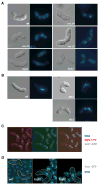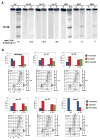A large-scale screen in S. pombe identifies seven novel genes required for critical meiotic events
- PMID: 16303567
- PMCID: PMC2721798
- DOI: 10.1016/j.cub.2005.10.038
A large-scale screen in S. pombe identifies seven novel genes required for critical meiotic events
Abstract
Meiosis is a specialized form of cell division by which sexually reproducing diploid organisms generate haploid gametes. During a long prophase, telomeres cluster into the bouquet configuration to aid chromosome pairing, and DNA replication is followed by high levels of recombination between homologous chromosomes (homologs). This recombination is important for the reductional segregation of homologs at the first meiotic division; without further replication, a second meiotic division yields haploid nuclei. In the fission yeast Schizosaccharomyces pombe, we have deleted 175 meiotically upregulated genes and found seven genes not previously reported to be critical for meiotic events. Three mutants (rec24, rec25, and rec27) had strongly reduced meiosis-specific DNA double-strand breakage and recombination. One mutant (tht2) was deficient in karyogamy, and two (bqt1 and bqt2) were deficient in telomere clustering, explaining their defects in recombination and segregation. The moa1 mutant was delayed in premeiotic S phase progression and nuclear divisions. Further analysis of these mutants will help elucidate the complex machinery governing the special behavior of meiotic chromosomes.
Figures


Similar articles
-
Meiotic chromosome dynamics dependent upon the rec8(+), rec10(+) and rec11(+) genes of the fission yeast Schizosaccharomyces pombe.Genetics. 1999 Sep;153(1):57-68. doi: 10.1093/genetics/153.1.57. Genetics. 1999. PMID: 10471700 Free PMC article.
-
Live observation of fission yeast meiosis in recombination-deficient mutants: a study on achiasmate chromosome segregation.J Cell Sci. 2001 Aug;114(Pt 15):2843-53. doi: 10.1242/jcs.114.15.2843. J Cell Sci. 2001. PMID: 11683417
-
Rec25 and Rec27, novel linear-element components, link cohesin to meiotic DNA breakage and recombination.Curr Biol. 2008 Jun 3;18(11):849-54. doi: 10.1016/j.cub.2008.05.025. Curr Biol. 2008. PMID: 18514516 Free PMC article.
-
Homologous chromosome pairing in Schizosaccharomyces pombe.Yeast. 2006 Oct 15;23(13):977-89. doi: 10.1002/yea.1403. Yeast. 2006. PMID: 17072890 Review.
-
A bouquet of chromosomes.J Cell Sci. 2004 Aug 15;117(Pt 18):4025-32. doi: 10.1242/jcs.01363. J Cell Sci. 2004. PMID: 15316078 Review.
Cited by
-
Mcp5, a meiotic cell cortex protein, is required for nuclear movement mediated by dynein and microtubules in fission yeast.J Cell Biol. 2006 Apr 10;173(1):27-33. doi: 10.1083/jcb.200512129. Epub 2006 Apr 3. J Cell Biol. 2006. PMID: 16585273 Free PMC article.
-
Spo5/Mug12, a putative meiosis-specific RNA-binding protein, is essential for meiotic progression and forms Mei2 dot-like nuclear foci.Eukaryot Cell. 2006 Aug;5(8):1301-13. doi: 10.1128/EC.00099-06. Eukaryot Cell. 2006. PMID: 16896214 Free PMC article.
-
OsPRD2 is essential for double-strand break formation, but not spindle assembly during rice meiosis.Front Plant Sci. 2023 Jan 13;13:1122202. doi: 10.3389/fpls.2022.1122202. eCollection 2022. Front Plant Sci. 2023. PMID: 36714725 Free PMC article.
-
A genome-wide screen for sporulation-defective mutants in Schizosaccharomyces pombe.G3 (Bethesda). 2014 Apr 11;4(6):1173-82. doi: 10.1534/g3.114.011049. G3 (Bethesda). 2014. PMID: 24727291 Free PMC article.
-
Function of Cryptococcus neoformans KAR7 (SEC66) in karyogamy during unisexual and opposite-sex mating.Eukaryot Cell. 2012 Jun;11(6):783-94. doi: 10.1128/EC.00066-12. Epub 2012 Apr 27. Eukaryot Cell. 2012. PMID: 22544906 Free PMC article.
References
-
- Mata J, Lyne R, Burns G, Bahler J. The transcriptional program of meiosis and sporulation in fission yeast. Nat Genet. 2002;32:143–147. - PubMed
-
- Chu S, DeRisi J, Eisen M, Mulholland J, Botstein D, Brown PO, Herskowitz I. The transcriptional program of sporulation in budding yeast. Science. 1998;282:699–705. - PubMed
-
- Primig M, Williams RM, Winzeler EA, Tevzadze GG, Conway AR, Hwang SY, Davis RW, Esposito RE. The core meiotic transcriptome in budding yeasts. Nat Genet. 2000;26:415–423. - PubMed
-
- Rabitsch KP, Toth A, Galova M, Schleiffer A, Schaffner G, Aigner E, Rupp C, Penkner AM, Moreno-Borchart AC, Primig M, Esposito RE, Klein F, Knop M, Nasmyth K. A screen for genes required for meiosis and spore formation based on whole-genome expression. Curr Biol. 2001;11:1001–1009. - PubMed
Publication types
MeSH terms
Grants and funding
LinkOut - more resources
Full Text Sources
Molecular Biology Databases

